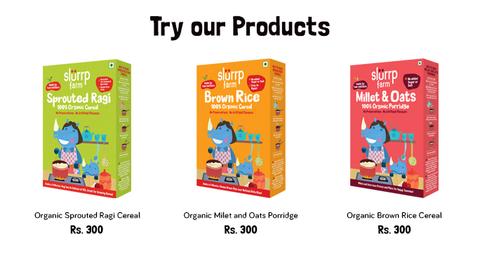The 6-month mark is the first milestone of you and your baby’s journey, congratulations on successfully making it through this! We imagine the last few months have been quite a ride and with a lot more to come, some anticipatory research is always a good idea.
Check out our 6 months old baby food chart.
The 6-month mark is especially important as this is when experts recommend you start weaning your child. Every mother and child is different and there are times when before or after 6 months seems right. There will be some signs that your child is ready for more than milk, a few of them are:
- Ability to sit up straight and swallow easily
- Increasing inquisitiveness at the dinner table and with new food items
- Willingness to reach for food and hold it in the hand
Babies can be quite effective at communication and your little one will be sure to let you know with some of these signs that it’s time to start thinking about weaning. There are a couple of different ways to go about weaning, two major schools of thoughts are:
- Traditional weaning
- Baby-led weaning
Traditional weaning goes old school where the parents are in charge. Here, babies are slowly introduced to semi-solids, baby cereals, and porridges. Semi-solid options like pieces of soft fruit and vegetable work well. There are also numerous options for baby cereals and porridges available that are made from different ingredients like millets, oats, rice, and wheat.
Traditional weaning takes all of these and combines it, offering you several alternatives to start offering your baby as you slowly start reducing the number of times you breastfeed them. A good way to start is by giving mashed fruits and vegetables mixed with milk so that there is some familiarity. Try this as a substitute for a breastfeeding session at a time of day where your child is a bit sleepy or tired, such that they are less likely to be cranky or notice the difference.
This process can take a while so make sure that you have a list of new options to keep trying with your baby. Also, keep in mind that your child might take some time to acclimatize to each of these options so do persist with them for some time. Try introducing items in different quantities, combinations, and even at different times of the day to see how your child reacts!
Baby-led weaning takes a slightly different approach wherein the child is put in the front seat. Here, you offer different options to your baby and let them experiment for themselves. Baby-led weaning encourages babies to be independent and take action and can be a great way to stimulate them and keep them active. Make sure to offer them food choices that are soft, easy to hold, and easy to swallow. This is also a good way to ensure no overeating as your baby shall stop eating once they are full, something that can be difficult to gauge in traditional weaning. Baby-led weaning is very messy however, encouraging babies to play around with food comes at a price! The number of variable factors here is higher than in traditional weaning and can, therefore, mean that parents need to spend more time overseeing their kids at mealtimes.
Both these methods of weaning take different approaches and both have pros and cons. The constant however is the quality of food items you are offering your child. This is the first time your baby will be having something other than milk and it is important that the food is clean, hygienic, and highly nutritious. Baby cereals can come especially in handy here as they have a fixed amount of vitamins and minerals they deliver per serving, making them easy to measure. Baby cereals can also be widely experimented with by adding fruits, vegetables, and other tastes and textures. For all this to work however it is important to ensure that the foundation baby cereal is healthy. This means that the healthiest baby cereals are ones that are organic and have no preservatives, artificial colors, or flavorings in them.
This thought process is one that lends itself well to anyone’s approach to food: focussing on simple and organic ingredients that provide a solid foundation for cooking and eating. This ideology is something that we strongly believe in and implement in our products too! Our range of baby cereals are made from organic ingredients and have no salt, refined sugar, or preservatives.

|

